Matador
100 kW
- Joined
- Jun 29, 2016
- Messages
- 1,045
After reading this "Use The Right Size Pack For Your Ebike Build : Ignore ‘Peak Power’ BMS Ratings" blog by Karl Gesslein (https://electricbike-blog.com/2017/01/07/use-the-right-size-pack-for-your-ebike-build-ignore-peak-power-bms-ratings/), I posted (still awaiting moderator approval/modifications) a comment on his blog because I enjoyed reading it, and I made me think more outside the box :
I was just thinking... We take the 18650-cell's manufacturer discharge current amp-rating for granted.
In my view, that rating is not a magical threshold/cutoff value bellow which a cell magically will stay cool and have the longest possible life. It sort of a continuum. A "dose-dependant relationship" if I may say by analogy.
For exemple that 30Q's 15-amp rating threshold is kind of abritrary and relies on what Samsumg believe is an acceptable drain for an okay temperature rise (81°C !!! once 100% discharged) and max cycle life.
Yet that HG2 is rated for a 20-amps by LG chem, but I've read somewhere that they perform slightly worst than the 30Q under similar condition, even though they have a higher amp rating.
I think 18650 lithium cell manufacturer's max discharge current rating are to take with a grain of salt. Knowing that temp is lithium cell's worst enemy, I think the best way to know what cells can take is to look for temperature rise curves at different discharge amp values on graphs. Like in this example : http://www.powerstream.com/18650-high-discharge-rate.htm
Also good to look for internal resistance charts at different SOC and temps. The DC-IR are obviously related to temperature curves at different discharge rates with ohm's law.
Just wanted to point that out : take those discharge current(amp)-rating values provided by manufacturer with a grain of salt.
For some reason, my post on Karl blog is still awaiting moderation and doesn't seem to pass that step. So here is my opinion on the subject (my original answer to his post). Here it is :
EDIT : My post has been aproved witout any moderator modifications on Karls blog. Here it is anyways :
______________________________________________________________________________________________________________________________________
I think the “amp-rating of a lithium cell” is not a “dogmatic exact cutoff/threshold value” that will garantee the cell will last if you stay exactly at, or just below that value… It’s more of a “dose-dependant relashionship”. In my opinion, there is a direct relationship between the chronic stress-load (in amps) imposed/drawn on a pack, the magnitude of it’s chronic temperature rise and ultimately, it’s cycle life. Heat (my personal cutoff is 50°C) is lithium cell’s worst enemy when it comes to battery cycle life. Sure you can completely drain a PF-cell (10amp-rated) or a 30Q-cell (15amp-rated) at exactly that 10 or 15 amp rating per cell respectively, but at what cost (maybe fine in acute emergency power usage needs, but bad in a chronic usage setting) !!! Temperature of these cells at these load values will rise at or above 75° !!!! See for yourself with scientific graphs (the scientific method is better than the dogmatic method IMHO) : https://endless-sphere.com/forums/viewtopic.php?f=14&t=68556&start=200#p1251357. Temp wil presumably rise even more than that when the cells are packed together in an enclosed, non-ventilated battery box/heatshrink. The less the temperature rises, the better it is for the cells cycle life. Temp will not just start to dangerously rise once you magically cross that 15A cell’s stated amp-rating value… Temp will proportionally rise according to the amp draw rate imposed on it. The more you pull the more it cooks. Look at this graphical exemple… If you completely drain a cell at a higher amp-draw curve, in then end the temperature wil be much higher, it’s not rocket science. This website shows that in very graphical manner… look at temperature curves : http://www.powerstream.com/18650-high-discharge-rate.htm
So sure a Mighty Mini Cube (14S 2P) made with good 15amp-rated 30Q-cells will be rated for max 30 amp-draw (2P x 15amps = 30 amps), and it will work with the 30A-BBSHD (surely not with a Ludacriss BBSHD@50A on throttle only mode though)… But if you pull 30amps ALL THE TIME out of that 30amp-rated 2P Mighty Mini Cube pack (the better one, with 30Q cells) until you COMPLETELY drain the pack @30Amps all the time, then the TEMPERATURE OF CELLS WILL RISE ABOVE 75°C! THAT IS NOT GOOD for a long term cell life IMHO. Somebody made the experience in the past and it’s 2P battery pack quickely failed on his BBSHD : https://endless-sphere.com/forums/viewtopic.php?f=6&t=83238&hilit=Sony+VTC4&start=25#p1250578
I tend to stay conservator with battery ratings in order to enjoy a long battery life (high number of charge cycles). What it think is good IMHO is posted on this forum link (at least double-spec your pack for amps. Triple it or more if you can afford) : https://endless-sphere.com/forums/viewtopic.php?f=3&t=85629#p1252830
I enjoyed this article. Thanks for taking the time to explain beginners about battery amps rating. The battery is the most important and most expensive part of an ebike. We might as well make it last for more than a year !
______________________________________________________________________________________________________________________________________
I propose that this thread serves to post discharge curve of cells with their concordant superposed temperature rises curves... So we can get a sense of internal resistance of cells, and know what to expect from cells. I mean, do Sony even recommend that the VTC4 be allowed at 97°C to test at the rated "Magical dogmatic" 30A-rated threashold they claim ???? (see graph for VTC4 below). I really wonder if cells submitted to the max rating claimed have comparable life in cycles... Certain cell tolerate high temps without degrading ? Or is LiCoMnO2 just behaves the same in diffent manufacturer brands ? Otherwise are amps rating just are a manufacturing gimmick... Le me start the graph sharing (NB : remember with superimposed temp curves please)
Panasonic NCR18650 GA (Rated : 10A, 3500 mAh) rises to 62°C @ 100% DoD with 10A-load (as per max rating) :

Panasonic NCR18650 PF (Rated : 10A, 2900 mAh) rises to 65°C @ 100% DoD with 10A-load (as per max rating) :
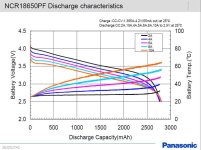 Somebody even pushed the PF to 15A at 100% DoD... Temp went up to 92°C ! (REF for graph : https://www.e-cigarette-forum.com/forum/threads/panasonic-ncr18650pf-10a-2680mah-18650-bench-test-results-a-great-battery-beats-mh1-and-mj1.692438/ )
Somebody even pushed the PF to 15A at 100% DoD... Temp went up to 92°C ! (REF for graph : https://www.e-cigarette-forum.com/forum/threads/panasonic-ncr18650pf-10a-2680mah-18650-bench-test-results-a-great-battery-beats-mh1-and-mj1.692438/ )
Sony US18650 VTC6 (Rated : 20A, 3000 mAh) rises to 88°C @ 100% DoD with 30A-load (as per max rating) :
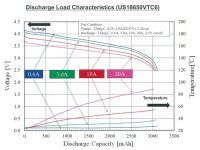
Samsung INR18650-30Q (Rated : 15A, 3000 mAh) rises to 81°C @ 100% DoD with 15A-load (as per max rating) :
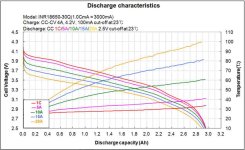
Samsung INR18650-25R (Rated : 20A, 2500 mAh) rises to 95°C @ 100% DoD with 20A-load (as per max rating) :
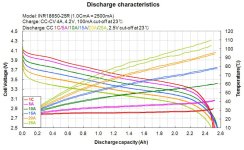
Sony US18650 VTC5 (Rated : 20A, 2600 mAh) rises to 77°C @ 100% DoD with 20A-load (as per max rating) :
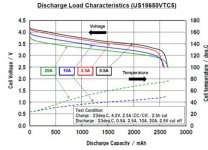
Sony US18650 VTC4 (Rated : 30A, 2100 mAh) rises to 97°C @ 100% DoD with 30A-load (as per max rating) :
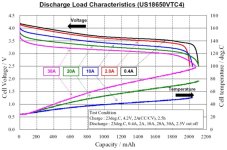
Sony US18650 VTC3 (Rated : 30A, 1600 mAh) rises to 83°C @ 100% DoD with 30A-load (as per max rating) : (sorry, I could not find better data for temp curves ; these are old technology cells).
View attachment 2
I was just thinking... We take the 18650-cell's manufacturer discharge current amp-rating for granted.
In my view, that rating is not a magical threshold/cutoff value bellow which a cell magically will stay cool and have the longest possible life. It sort of a continuum. A "dose-dependant relationship" if I may say by analogy.
For exemple that 30Q's 15-amp rating threshold is kind of abritrary and relies on what Samsumg believe is an acceptable drain for an okay temperature rise (81°C !!! once 100% discharged) and max cycle life.
Yet that HG2 is rated for a 20-amps by LG chem, but I've read somewhere that they perform slightly worst than the 30Q under similar condition, even though they have a higher amp rating.
I think 18650 lithium cell manufacturer's max discharge current rating are to take with a grain of salt. Knowing that temp is lithium cell's worst enemy, I think the best way to know what cells can take is to look for temperature rise curves at different discharge amp values on graphs. Like in this example : http://www.powerstream.com/18650-high-discharge-rate.htm
Also good to look for internal resistance charts at different SOC and temps. The DC-IR are obviously related to temperature curves at different discharge rates with ohm's law.
Just wanted to point that out : take those discharge current(amp)-rating values provided by manufacturer with a grain of salt.
For some reason, my post on Karl blog is still awaiting moderation and doesn't seem to pass that step. So here is my opinion on the subject (my original answer to his post). Here it is :
EDIT : My post has been aproved witout any moderator modifications on Karls blog. Here it is anyways :
______________________________________________________________________________________________________________________________________
I think the “amp-rating of a lithium cell” is not a “dogmatic exact cutoff/threshold value” that will garantee the cell will last if you stay exactly at, or just below that value… It’s more of a “dose-dependant relashionship”. In my opinion, there is a direct relationship between the chronic stress-load (in amps) imposed/drawn on a pack, the magnitude of it’s chronic temperature rise and ultimately, it’s cycle life. Heat (my personal cutoff is 50°C) is lithium cell’s worst enemy when it comes to battery cycle life. Sure you can completely drain a PF-cell (10amp-rated) or a 30Q-cell (15amp-rated) at exactly that 10 or 15 amp rating per cell respectively, but at what cost (maybe fine in acute emergency power usage needs, but bad in a chronic usage setting) !!! Temperature of these cells at these load values will rise at or above 75° !!!! See for yourself with scientific graphs (the scientific method is better than the dogmatic method IMHO) : https://endless-sphere.com/forums/viewtopic.php?f=14&t=68556&start=200#p1251357. Temp wil presumably rise even more than that when the cells are packed together in an enclosed, non-ventilated battery box/heatshrink. The less the temperature rises, the better it is for the cells cycle life. Temp will not just start to dangerously rise once you magically cross that 15A cell’s stated amp-rating value… Temp will proportionally rise according to the amp draw rate imposed on it. The more you pull the more it cooks. Look at this graphical exemple… If you completely drain a cell at a higher amp-draw curve, in then end the temperature wil be much higher, it’s not rocket science. This website shows that in very graphical manner… look at temperature curves : http://www.powerstream.com/18650-high-discharge-rate.htm
So sure a Mighty Mini Cube (14S 2P) made with good 15amp-rated 30Q-cells will be rated for max 30 amp-draw (2P x 15amps = 30 amps), and it will work with the 30A-BBSHD (surely not with a Ludacriss BBSHD@50A on throttle only mode though)… But if you pull 30amps ALL THE TIME out of that 30amp-rated 2P Mighty Mini Cube pack (the better one, with 30Q cells) until you COMPLETELY drain the pack @30Amps all the time, then the TEMPERATURE OF CELLS WILL RISE ABOVE 75°C! THAT IS NOT GOOD for a long term cell life IMHO. Somebody made the experience in the past and it’s 2P battery pack quickely failed on his BBSHD : https://endless-sphere.com/forums/viewtopic.php?f=6&t=83238&hilit=Sony+VTC4&start=25#p1250578
I tend to stay conservator with battery ratings in order to enjoy a long battery life (high number of charge cycles). What it think is good IMHO is posted on this forum link (at least double-spec your pack for amps. Triple it or more if you can afford) : https://endless-sphere.com/forums/viewtopic.php?f=3&t=85629#p1252830
I enjoyed this article. Thanks for taking the time to explain beginners about battery amps rating. The battery is the most important and most expensive part of an ebike. We might as well make it last for more than a year !
______________________________________________________________________________________________________________________________________
I propose that this thread serves to post discharge curve of cells with their concordant superposed temperature rises curves... So we can get a sense of internal resistance of cells, and know what to expect from cells. I mean, do Sony even recommend that the VTC4 be allowed at 97°C to test at the rated "Magical dogmatic" 30A-rated threashold they claim ???? (see graph for VTC4 below). I really wonder if cells submitted to the max rating claimed have comparable life in cycles... Certain cell tolerate high temps without degrading ? Or is LiCoMnO2 just behaves the same in diffent manufacturer brands ? Otherwise are amps rating just are a manufacturing gimmick... Le me start the graph sharing (NB : remember with superimposed temp curves please)
Panasonic NCR18650 GA (Rated : 10A, 3500 mAh) rises to 62°C @ 100% DoD with 10A-load (as per max rating) :

Panasonic NCR18650 PF (Rated : 10A, 2900 mAh) rises to 65°C @ 100% DoD with 10A-load (as per max rating) :
 Somebody even pushed the PF to 15A at 100% DoD... Temp went up to 92°C ! (REF for graph : https://www.e-cigarette-forum.com/forum/threads/panasonic-ncr18650pf-10a-2680mah-18650-bench-test-results-a-great-battery-beats-mh1-and-mj1.692438/ )
Somebody even pushed the PF to 15A at 100% DoD... Temp went up to 92°C ! (REF for graph : https://www.e-cigarette-forum.com/forum/threads/panasonic-ncr18650pf-10a-2680mah-18650-bench-test-results-a-great-battery-beats-mh1-and-mj1.692438/ )Sony US18650 VTC6 (Rated : 20A, 3000 mAh) rises to 88°C @ 100% DoD with 30A-load (as per max rating) :

Samsung INR18650-30Q (Rated : 15A, 3000 mAh) rises to 81°C @ 100% DoD with 15A-load (as per max rating) :

Samsung INR18650-25R (Rated : 20A, 2500 mAh) rises to 95°C @ 100% DoD with 20A-load (as per max rating) :

Sony US18650 VTC5 (Rated : 20A, 2600 mAh) rises to 77°C @ 100% DoD with 20A-load (as per max rating) :

Sony US18650 VTC4 (Rated : 30A, 2100 mAh) rises to 97°C @ 100% DoD with 30A-load (as per max rating) :

Sony US18650 VTC3 (Rated : 30A, 1600 mAh) rises to 83°C @ 100% DoD with 30A-load (as per max rating) : (sorry, I could not find better data for temp curves ; these are old technology cells).
View attachment 2



